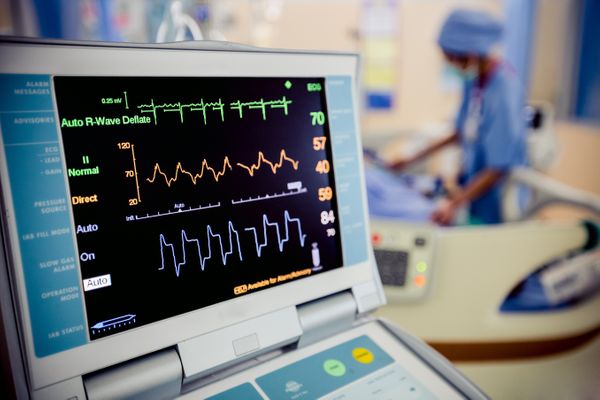10.3.1
Electrocardiography (ECG)
ECG Machines
ECG Machines
An electrocardiogram (ECG) is a record of the voltages created by the wave of depolarization and repolarization in the heart.


The heart
The heart
- The heart is made up of four chambers, the top two being atriums, the bottom two being ventricles.
- The right and left atria receive blood from the body and lungs, respectively, and pump the blood into the ventricles.
- The right and left ventricles, in turn, pump blood through the lungs and the rest of the body, respectively.


Polarization
Polarization
- Depolarization of the heart muscle causes it to contract. After contraction, it is repolarized to ready it for the next beat.
- The ECG measures components of depolarization and repolarization of the heart muscle.
- An ECG can give us a lot of information about if the heart is functioning well.
ECG Waveform
ECG Waveform
The heartbeat and polarization waves create a characteristic waveform.


P wave
P wave
- The major features of an ECG wave are labelled P, Q, R, S, and T.
- The P wave is from the depolarization and contraction of the atria as they pump blood into the ventricles.


QRS wave
QRS wave
- The QRS part of the wave is created by the depolarization of the ventricles as they pump blood to the lungs and body.
- The QRS complex has this typical shape and time span.
- The QRS signal also masks the repolarization of the atria, which occur at the same time.


T wave
T wave
- Finally, the T wave is generated by the repolarization of the ventricles.
- The T wave is followed by the next P wave in the next heartbeat.
1Measurements & Errors
1.1Measurements & Errors
1.1.1SI Base Units
1.1.2Combining SI Units
1.1.3Prefixes of Units
1.1.4Standard Form
1.1.5Converting Units
1.1.6End of Topic Test - Units & Prefixes
1.1.7Limitation of Physical Measurements
1.1.8Uncertainty
1.1.9Estimation
1.1.10End of Topic Test - Measurements & Errors
1.1.11Diagnostic Misconceptions - Converting between SI
1.1.12Diagnostic Misconceptions - SI & Area/Volume
2Particles & Radiation
2.1Particles
2.1.1Atomic Model
2.1.2Specific Charge, Protons & Neutron Numbers
2.1.3End of Topic Test - Atomic Model
2.1.4Isotopes
2.1.5Stable & Unstable Nuclei
2.1.6End of Topic Test - Isotopes & Nuclei
2.1.7A-A* (AO3/4) - Stable & Unstable Nuclei
2.1.8Particles, Antiparticles & Photons
2.1.9Particle Interactions
2.1.10Classification of Particles
2.1.11End of Topic Test - Particles & Interactions
2.1.12Quarks & Antiquarks
2.1.13Application of Conservation Laws
2.1.14End of Topic Test - Leptons & Quarks
2.1.15Exam-Style Question - Radioactive Decay
2.2Electromagnetic Radiation & Quantum Phenomena
2.2.1The Photoelectric Effect
2.2.2The Photoelectric Effect Explanation
2.2.3End of Topic Test - The Photoelectric Effect
2.2.4Collisions of Electrons with Atoms
2.2.5Energy Levels & Photon Emission
2.2.6Wave-Particle Duality
2.2.7End of Topic Test - Absorption & Emission
2.2.8Diagnostic Misconceptions - Electron Volts
2.2.9Diagnostic Misconceptions - Converting eV & Joules
3Waves
3.1Progressive & Stationary Waves
3.2Refraction, Diffraction & Interference
4Mechanics & Materials
4.1Force, Energy & Momentum
4.1.1Scalars & Vectors
4.1.2Vector Problems
4.1.3End of Topic Test - Scalars & Vectors
4.1.4Moments
4.1.5Centre of Mass
4.1.6End of Topic Test - Moments & Centre of Mass
4.1.7Motion in a Straight Line
4.1.8Graphs of Motion
4.1.9Bouncing Ball Example
4.1.10End of Topic Test - Motion in a Straight Line
4.1.11Acceleration Due to Gravity
4.1.12Projectile Motion
4.1.13Friction
4.1.14Terminal Speed
4.1.15End of Topic Test - Acceleration Due to Gravity
4.1.16Newton's Laws
4.1.17Momentum
4.1.18Momentum 2
4.1.19End of Topic Test - Newton's Laws & Momentum
4.1.20A-A* (AO3/4) - Newton's Third Law
4.1.21Work & Energy
4.1.22Power & Efficiency
4.1.23Conservation of Energy
4.1.24End of Topic Test - Work, Energy & Power
4.1.25Exam-Style Question - Forces
4.1.26Diagnostic Misconceptions - Perpendicular Vectors
4.1.27Diagnostic Misconceptions - Weight Acts Downwards
4.1.28Diagnostic Misconceptions - Acceleration Direction
4.1.29Diagnostic Misconceptions - Stationary Objects
4.1.30Diagnostic Misconceptions - Action & Reaction
4.1.31Diagnostic Misconceptions - RF Direction
4.1.32Diagnostic Misconceptions - RF Acceleration
4.1.33Diagnostic Misconceptions - Change in Momentum
5Electricity
5.1Current Electricity
5.1.1Basics of Electricity
5.1.2Current-Voltage Characteristics
5.1.3End of Topic Test - Basics of Electricity
5.1.4Resistivity
5.1.5Superconductivity
5.1.6A-A* (AO3/4) - Superconductivity
5.1.7End of Topic Test - Resistivity & Superconductors
5.1.8Circuits
5.1.9Power and Conservation
5.1.10Potential Divider
5.1.11Emf & Internal Resistance
5.1.12End of Topic Test - Power & Potential
5.1.13Exam-Style Question - Resistance
5.1.14Diagnostic Misconceptions - Constant Current
5.1.15Diagnostic Misconceptions - Potential Difference
6Further Mechanics & Thermal Physics (A2 only)
6.1Periodic Motion (A2 only)
6.2Thermal Physics (A2 only)
6.2.1Thermal Energy Transfer
6.2.2Thermal Energy Transfer Experiments
6.2.3Ideal Gases
6.2.4Ideal Gases 2
6.2.5Boyle's Law & Charles' Law
6.2.6Molecular Kinetic Theory Model
6.2.7Molecular Kinetic Theory Model 2
6.2.8End of Topic Test - Thermal Energy & Ideal Gases
6.2.9Exam-Style Question - Ideal Gases
6.2.10Diagnostic Misconceptions - Material & Mass
6.2.11Diagnostic Misconceptions - No Energy
7Fields & Their Consequences (A2 only)
7.1Fields (A2 only)
7.2Gravitational Fields (A2 only)
7.3Electric Fields (A2 only)
7.4Capacitance (A2 only)
7.5Magnetic Fields (A2 only)
7.5.1Magnetic Flux Density
7.5.2End of Topic Test - Capacitance & Flux Density
7.5.3Moving Charges in a Magnetic Field
7.5.4Magnetic Flux & Flux Linkage
7.5.5Electromagnetic Induction
7.5.6Electromagnetic Induction 2
7.5.7Alternating Currents
7.5.8Operation of a Transformer
7.5.9Magnetic Flux Density
7.5.10End of Topic Test - Electromagnetic Induction
8Nuclear Physics (A2 only)
8.1Radioactivity (A2 only)
8.1.1Rutherford Scattering
8.1.2Alpha & Beta Radiation
8.1.3Gamma Radiation
8.1.4Radioactive Decay
8.1.5Half Life
8.1.6End of Topic Test - Radioactivity
8.1.7Nuclear Instability
8.1.8Nuclear Radius
8.1.9Mass & Energy
8.1.10Binding Energy
8.1.11Induced Fission
8.1.12Safety Aspects of Nuclear Reactors
8.1.13End of Topic Test - Nuclear Physics
8.1.14A-A* (AO3/4) - Nuclear Fusion
9Option: Astrophysics (A2 only)
9.1Telescopes (A2 only)
9.2Classification of Stars (A2 only)
9.3Cosmology (A2 only)
10Option: Medical Physics (A2 only)
10.1Physics of the Eye (A2 only)
10.2Physics of the Ear (A2 only)
10.3Biological Measurement (A2 only)
10.4Non-Ionising Imaging (A2 only)
10.5X-Ray Imaging (A2 only)
10.6Radionuclide Imaging & Therapy (A2 only)
11Option: Engineering Physics (A2 only)
11.1Rotational Dynamics (A2 only)
11.2Thermodynamics & Engines (A2 only)
12Option: Turning Points in Physics (A2 only)
12.1Discovery of the Electron (A2 only)
12.2Wave-Particle Duality (A2 only)
Jump to other topics
1Measurements & Errors
1.1Measurements & Errors
1.1.1SI Base Units
1.1.2Combining SI Units
1.1.3Prefixes of Units
1.1.4Standard Form
1.1.5Converting Units
1.1.6End of Topic Test - Units & Prefixes
1.1.7Limitation of Physical Measurements
1.1.8Uncertainty
1.1.9Estimation
1.1.10End of Topic Test - Measurements & Errors
1.1.11Diagnostic Misconceptions - Converting between SI
1.1.12Diagnostic Misconceptions - SI & Area/Volume
2Particles & Radiation
2.1Particles
2.1.1Atomic Model
2.1.2Specific Charge, Protons & Neutron Numbers
2.1.3End of Topic Test - Atomic Model
2.1.4Isotopes
2.1.5Stable & Unstable Nuclei
2.1.6End of Topic Test - Isotopes & Nuclei
2.1.7A-A* (AO3/4) - Stable & Unstable Nuclei
2.1.8Particles, Antiparticles & Photons
2.1.9Particle Interactions
2.1.10Classification of Particles
2.1.11End of Topic Test - Particles & Interactions
2.1.12Quarks & Antiquarks
2.1.13Application of Conservation Laws
2.1.14End of Topic Test - Leptons & Quarks
2.1.15Exam-Style Question - Radioactive Decay
2.2Electromagnetic Radiation & Quantum Phenomena
2.2.1The Photoelectric Effect
2.2.2The Photoelectric Effect Explanation
2.2.3End of Topic Test - The Photoelectric Effect
2.2.4Collisions of Electrons with Atoms
2.2.5Energy Levels & Photon Emission
2.2.6Wave-Particle Duality
2.2.7End of Topic Test - Absorption & Emission
2.2.8Diagnostic Misconceptions - Electron Volts
2.2.9Diagnostic Misconceptions - Converting eV & Joules
3Waves
3.1Progressive & Stationary Waves
3.2Refraction, Diffraction & Interference
4Mechanics & Materials
4.1Force, Energy & Momentum
4.1.1Scalars & Vectors
4.1.2Vector Problems
4.1.3End of Topic Test - Scalars & Vectors
4.1.4Moments
4.1.5Centre of Mass
4.1.6End of Topic Test - Moments & Centre of Mass
4.1.7Motion in a Straight Line
4.1.8Graphs of Motion
4.1.9Bouncing Ball Example
4.1.10End of Topic Test - Motion in a Straight Line
4.1.11Acceleration Due to Gravity
4.1.12Projectile Motion
4.1.13Friction
4.1.14Terminal Speed
4.1.15End of Topic Test - Acceleration Due to Gravity
4.1.16Newton's Laws
4.1.17Momentum
4.1.18Momentum 2
4.1.19End of Topic Test - Newton's Laws & Momentum
4.1.20A-A* (AO3/4) - Newton's Third Law
4.1.21Work & Energy
4.1.22Power & Efficiency
4.1.23Conservation of Energy
4.1.24End of Topic Test - Work, Energy & Power
4.1.25Exam-Style Question - Forces
4.1.26Diagnostic Misconceptions - Perpendicular Vectors
4.1.27Diagnostic Misconceptions - Weight Acts Downwards
4.1.28Diagnostic Misconceptions - Acceleration Direction
4.1.29Diagnostic Misconceptions - Stationary Objects
4.1.30Diagnostic Misconceptions - Action & Reaction
4.1.31Diagnostic Misconceptions - RF Direction
4.1.32Diagnostic Misconceptions - RF Acceleration
4.1.33Diagnostic Misconceptions - Change in Momentum
5Electricity
5.1Current Electricity
5.1.1Basics of Electricity
5.1.2Current-Voltage Characteristics
5.1.3End of Topic Test - Basics of Electricity
5.1.4Resistivity
5.1.5Superconductivity
5.1.6A-A* (AO3/4) - Superconductivity
5.1.7End of Topic Test - Resistivity & Superconductors
5.1.8Circuits
5.1.9Power and Conservation
5.1.10Potential Divider
5.1.11Emf & Internal Resistance
5.1.12End of Topic Test - Power & Potential
5.1.13Exam-Style Question - Resistance
5.1.14Diagnostic Misconceptions - Constant Current
5.1.15Diagnostic Misconceptions - Potential Difference
6Further Mechanics & Thermal Physics (A2 only)
6.1Periodic Motion (A2 only)
6.2Thermal Physics (A2 only)
6.2.1Thermal Energy Transfer
6.2.2Thermal Energy Transfer Experiments
6.2.3Ideal Gases
6.2.4Ideal Gases 2
6.2.5Boyle's Law & Charles' Law
6.2.6Molecular Kinetic Theory Model
6.2.7Molecular Kinetic Theory Model 2
6.2.8End of Topic Test - Thermal Energy & Ideal Gases
6.2.9Exam-Style Question - Ideal Gases
6.2.10Diagnostic Misconceptions - Material & Mass
6.2.11Diagnostic Misconceptions - No Energy
7Fields & Their Consequences (A2 only)
7.1Fields (A2 only)
7.2Gravitational Fields (A2 only)
7.3Electric Fields (A2 only)
7.4Capacitance (A2 only)
7.5Magnetic Fields (A2 only)
7.5.1Magnetic Flux Density
7.5.2End of Topic Test - Capacitance & Flux Density
7.5.3Moving Charges in a Magnetic Field
7.5.4Magnetic Flux & Flux Linkage
7.5.5Electromagnetic Induction
7.5.6Electromagnetic Induction 2
7.5.7Alternating Currents
7.5.8Operation of a Transformer
7.5.9Magnetic Flux Density
7.5.10End of Topic Test - Electromagnetic Induction
8Nuclear Physics (A2 only)
8.1Radioactivity (A2 only)
8.1.1Rutherford Scattering
8.1.2Alpha & Beta Radiation
8.1.3Gamma Radiation
8.1.4Radioactive Decay
8.1.5Half Life
8.1.6End of Topic Test - Radioactivity
8.1.7Nuclear Instability
8.1.8Nuclear Radius
8.1.9Mass & Energy
8.1.10Binding Energy
8.1.11Induced Fission
8.1.12Safety Aspects of Nuclear Reactors
8.1.13End of Topic Test - Nuclear Physics
8.1.14A-A* (AO3/4) - Nuclear Fusion
9Option: Astrophysics (A2 only)
9.1Telescopes (A2 only)
9.2Classification of Stars (A2 only)
9.3Cosmology (A2 only)
10Option: Medical Physics (A2 only)
10.1Physics of the Eye (A2 only)
10.2Physics of the Ear (A2 only)
10.3Biological Measurement (A2 only)
10.4Non-Ionising Imaging (A2 only)
10.5X-Ray Imaging (A2 only)
10.6Radionuclide Imaging & Therapy (A2 only)
11Option: Engineering Physics (A2 only)
11.1Rotational Dynamics (A2 only)
11.2Thermodynamics & Engines (A2 only)
12Option: Turning Points in Physics (A2 only)
12.1Discovery of the Electron (A2 only)
12.2Wave-Particle Duality (A2 only)
Unlock your full potential with Seneca Premium
Unlimited access to 10,000+ open-ended exam questions
Mini-mock exams based on your study history
Unlock 800+ premium courses & e-books